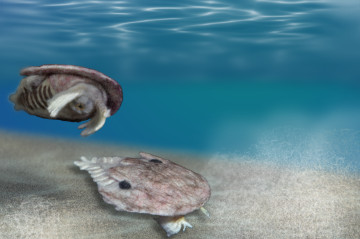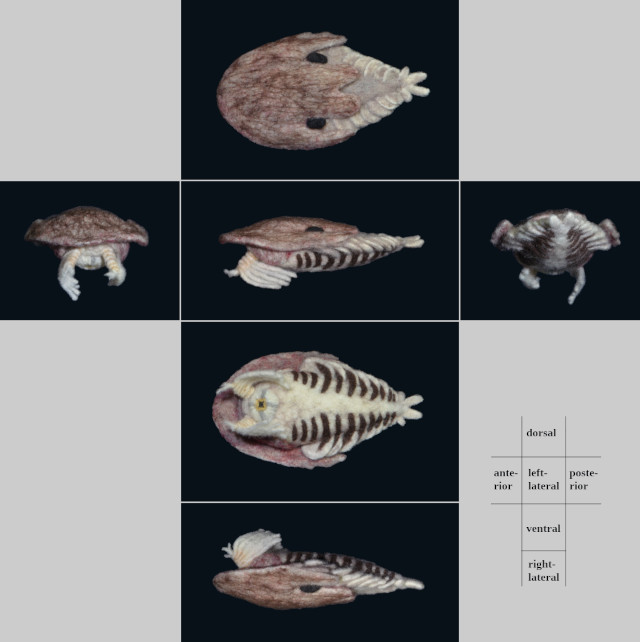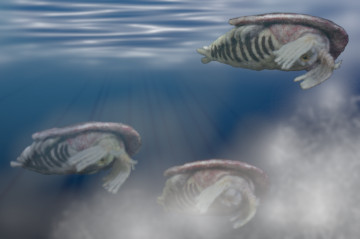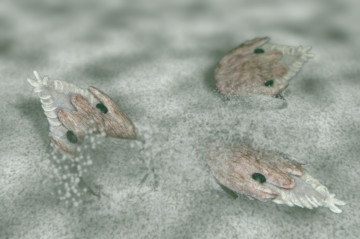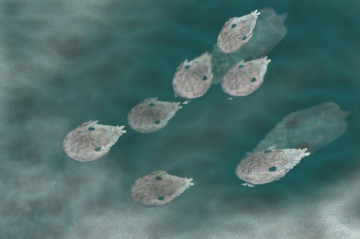Cambroraster falcatus
Cambroraster falcatus, which was found from the Middle Cambrian Burgess Shale (about 509 million years - 504.5 million years ago, British Columbia, Canada), is a species of Family Hurdiidae, Order Radiodonta 3), and another species of Cambroraster also occurred from the Chengjiang Fauna of South China 4).
Genus name "Cambroraster" comes from "Cambrian" and the rake-like shape of frontal appendage, species name "falcatus" is derived from the sickle-shape H-element 3). The shape of Cambroraster is resemble the "Millenium Falcon", Han Solo's star ship in the movie "Star Wars" produced by Lucasfilm Ltd., that is one of reasons 3).
Cambroraster is approximately 30 cm in length, 18 cm in mamimum width 3). The frontal shield complex occupy about half of the total body lenghth 3). This frontal carapace complex consists of a broad, sickle-shaped or horseshoe-shaped carapace, namely H-element, and beneath it, a pair of lateral P-elements, connecting at the anterior edge 3).
There is an oral cone (a mouth apparatus), characteristic of radiodont, on the ventral surface of the head, with a pair of frontal appendages on each side 3).
A pair of the elliptic eyes protrudes dorsally from the notches on either side of the posterior edge of the H-element 3).
The oral cone consists of twenty-eight small plates delimited seven each by four large plates shaping tetra-radial outer array, and has inner serrated plates in its central opening 3).
The frontal appendages are oval in cross section, with five endites (a branch of the appendage) which are almost same length, curving inside, and on their frontal edge, bearing a number of secondary (or auxiliary) spines alternating in their size 3). They are rake-like shape as a whole and are arranged in surrounding the oral cone 3).
The trunk is short in length and triangular in section, with eight pairs of lateral flaps 3). Structures that appears to be thin lamellae bands found in other radiodonts, extend from near the body axis to each flaps 3). Three pairs of these bands are found in front of the first flap 3). Presumably, these are setal blades.
Two pairs of small tail fin-like structures are on the posterior end of the body 3).
Considering its body shape, it is unlikely a nektonic (swimming) predator.Moreover the appendages are unsuitable for carnivorous function, Cambroraster may have been swimming near the sea floor, filtering and eating the sediments 3). Presumed feeding scenario is as follows: they stir the sediments by their frontal appendages, and filter suspension by basket-shape structure formed by the appendages, then suction small preys by the oral cone 3).
However, robust appendages are required to plow up the sediments, and the appendages of Cambroraster are too delicate, then based on these discussion, the idea that Cambroraster should be a supension-feeder has also been proposed 2). Alternatively, there is a possibility that Cambroraster dug up the sediments by their head shield and filtered infaunal(animals live in sediments) micro-organisms from the agitated suspension 2).
Presumably, they had been behaving mass moulting because of the accumlation of these fossils at the same place 3).
Cambroraster and Titanokorys are found from the same bedding surfaces 1), it is possible that they lived in the same area at the same time. Had they ate the same size and type of prey in the same way, competition was inevitable, and there may have been some differences in feeding strategies between them.
Created in January - March 2022.
References:
- Caron JB, Moysiuk J (2021) A giant nektobenthic radiodont from the Burgess Shale and the significance of hurdiid carapace diversity. R. Soc. Open Sci. 8: 210664. (DOI: 10.1098/rsos.210664)
- De Vivo G, Lautenschlager S, Vinther J. (2021) Three-dimensional modelling, disparity and ecology of the first Cambrian apex predators. Proc. R. Soc. B 288: 20211176. (DOI: 10.1098/rspb.2021.1176)
- Moysiuk J, Caron JB (2019) A new hurdiid radiodont from the Burgess Shale evinces the exploitation of Cambrian infaunal food sources. Proc. R. Soc. B 286:20191079. (DOI:10.1098/rspb.2019.1079)
- Liu Y, Lerosey-Aubril R, Audo D, Zhai D, Mai H, Ortega-Hernández J (2020) Occurrence of the eudemersal radiodont Cambroraster in the early Cambrian Chengjiang Lagerstätte and the diversity of hurdiid ecomorphotypes. [abstract] Geol. Mag. 157(7): 1200 - 1206. (DOI: 10.1017/S0016756820000187)

